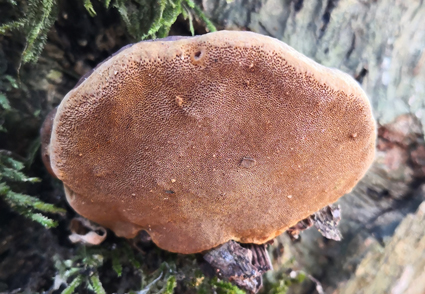Abstract
Fulvifomes parviungulatus sp. nov. is described and illustrated from China based on morphological characters and phylogenetic analyses. The sequences of the internal transcribed spacer (ITS) region and nuclear-encoded large subunit rRNA gene (28S) were employed. Fulvifomes parviungulatus is characterized by the perennial, small and ungulate basidiocarps, crusted, smooth pileal surface, 4–5 pores per mm with thick dissepiments, a dimitic hyphal system with interwoven skeletal hyphae, absence of ventricose cystidioles, collapsed hymenium in the studied material and ellipsoid, yellowish brown, thick-walled, smooth basidiospores measuring 4.2–4.7 × 3.5–4 μm. The new species was compared with its related taxa and a molecular study supports it with in the genus of Fulvifomes.
References
- Anonymous (1969) Flora of British fungi. Colour identification chart. Her Majesty´s Stationery Office, London.
- Chenna, R., Sugawara, H., Koike, T., Lopez, R., Gibson, T.J., Higgins, D.G. & Thompson, J.D. (2003) Multiple sequence alignment with the Clustal series of programs. Nucleic Acids Research 31: 3497–3500. https://doi.org/10.1093/nar/gkg500
- Dai, Y.C. (2010) Hymenochaetaceae (Basidiomycota) in China. Fungal Diversity 45: 131–343. https://doi.org/10.1007/s13225-010-0066-9
- Darriba, D., Taboada, G.L., Doallo, R. & Posada, D. (2012) jModelTest 2: more models, new heuristics and parallel computing. Nature Methods 9: 772. https://doi.org/10.1038/nmeth.2109
- Gilbertson, R.L. & Ryvarden, L. (1987) North American polypores. Vol. I. Abortiporus-Lindtneria. Fungiflora, Oslo, 433 pp. https://doi.org/10.1002/jobm.3620270513
- Guindon, S. & Gascuel, O. (2003) A simple, fast and accurate method to estimate large phylogenies by maximum-likelihood. Systematic Biology 52: 696–704. https://doi.org/10.1080/10635150390235520
- Hall, T.A. (1999) Bioedit: a user-friendly biological sequence alignment editor and analysis program for windows 95/98/NT. Nucleic Acids Symposium Series 41: 95–98.
- Ji, X.H., Wu, F., Dai, Y.C. & Vlasák, J. (2017) Two new species of Fulvifomes (Hymenochaetales, Basidiomycota) from America. MycoKeys 22: 1–13. https://doi.org/10.3897/mycokeys.22.12380
- Larsen, M.J. & Cobb-Poulle, L.A. (1990) Phellinus (Hymenochaetaceae). A survey of the world taxa. Synopsis Fungorum 3: 1–206.
- Liu, G.H., Ji, X.H., Wang, Y.P. & Chen, J.J. (2020) A new species of Fulvifomes (Basidiomycota) from China. Phytotaxa 470: 194–202. https://doi.org/10.11646/phytotaxa.470.2.8
- Murrill, M.A. (1903) The Polyporaceae of North America 2. The genus Pyropolyporus. Bull Torrey Bot Club 30: 109–120. https://doi.org/10.2307/2478882
- Murrill, M.A. (1914) Northern polypores. Published by the Author, New York, 49 pp. https://doi.org/10.5962/bhl.title.45986
- Murrill, M.A. (1915) Tropical polypores. Published by the Author, New York, 113 pp. https://doi.org/10.5962/bhl.title.22996
- Núñez, M. & Ryvarden, L. (2000) East Asian polypores 1. Ganodermataceae and Hymenochaetaceae. Synopsis Fungorum 13: 1–168.
- Page, R.D.M. (1996) Treeview: application to display phylogenetic trees on personal computers. Computer Applications in the Biosciences 12: 357–358. https://doi.org/10.1093/bioinformatics/12.4.357
- Pattengale, N.D., Alipour, M., Bininda-Emonds, O.R.P., Moret, B.M.E. & Stamatakis, A. (2010) How many bootstrap replicates are necessary? Journal of Computational Biology 17: 337–354. https://doi.org/10.1089/cmb.2009.0179
- Petersen, J.H. (1996) Farvekort. The Danish Mycological Society´s colour-chart. Foreningen til Svampekundskabens Fremme, Greve, 6 pp. .
- Quélet, L. (1886) Enchiridion Fungorum in Europa media et praesertim in Gallia Vigentium. 352 pp. https://doi.org/10.5962/bhl.title.47025
- Ronquist, F. & Huelsenbeck, J.P. (2003) MrBayes 3: Bayesian phylogenetic inference under mixed models. Bioinformatics 19: 1572–1574. https://doi.org/10.1093/bioinformatics/btg180
- Ryvarden, L. (1991) Genera of polypores. Nomenclature and taxonomy. Synopsis Fungorum 5: 1–363.
- Ryvarden, L. & Johansen, I. (1980) A preliminary polypore flora of East Africa. Fungiflora, Oslo, 636 pp.
- Silvestro, D. & Michalak, I. (2012) raxmlGUI: a graphical front-end for RAxML. Organisms Diversity & Evolution 12: 335–337. https://doi.org/10.1007/s13127-011-0056-0
- Salvador-Montoya, C.A., Popoff, O.F., Reck, M. & Drechsler-Santos, E.R. (2018) Taxonomic delimitation of Fulvifomes robiniae (Hymenochaetales, Basidiomycota) and related species in America: F. squamosus sp. nov. Plant Systematics and Evolution 304: 445–459. https://doi.org/10.1007/s00606-017-1487-7
- Stamatakis, A. (2006) RAxML-VI-HPC: maximum likelihoodbased phylogenetic analyses with thousands of taxa and mixed models. Bioinformatics 22: 2688–2690. https://doi.org/10.1093/bioinformatics/btl446
- Vu, D., Groenewald, M., de Vries, M., Gehrmann, T., Stielow, B., Eberhardt, U., Al-Hatmi, A., Groenewald, J.Z., Cardinali, G., Houbraken, J., Boekhout, T., Crous, P.W., Robert, V. & Verkley, G.J.M. (2019) Large-scale generation and analysis of filamentous fungal DNA barcodes boosts coverage for kingdom fungi and reveals thresholds for fungal species and higher taxon delimitation. Studies in Mycology 92: 135–154. https://doi.org/10.1016/j.simyco.2018.05.001
- Wagner, T. & Fischer, M. (2002) Proceedings towards a natural classification of the worldwide taxa Phellinus s.l. and Inonotus s.l., and phylogenetic relationships of allied genera. Mycologia 94: 998–1016. https://doi.org/10.1080/15572536.2003.11833156
- White, T.J., Bruns, T., Lee, S. & Taylor, J. (1990) Amplification and direct sequencing of fungal ribosomal RNA genes for phylogenetics. In: Innis, M.A., Gelfand, D.H., Sninsky, J.J. & White, T.J. (Eds.) PCR protocols, a guide to methods and applications. Academic Press, New York, pp. 315–322. https://doi.org/10.1016/B978-0-12-372180-8.50042-1
- Wu, F., Zhou, L.W., Vlasák, J. & Dai, Y.C. (2022) Global diversity and systematics of Hymenochaetaceae with poroid hymenophore. Fungal Diversity 113: 1–192. https://doi.org/10.1007/s13225-021-00496-4
- Zhou, L.W. (2014) Fulvifomes hainanensis sp. nov. and F. indicus comb. nov. (Hymenochaetales, Basidiomycota) evidenced by a combination of morphology and phylogeny. Mycoscience 55: 70–77. https://doi.org/10.1016/j.myc.2013.05.006
- Zhou, L.W. (2015) Fulvifomes imbricatus and F. thailandicus (Hymenochaetales, Basidiomycota): two new species from Thailand based on morphological and molecular evidence. Mycological Progress 14: 89. https://doi.org/10.1007/s11557-015-1116-1


